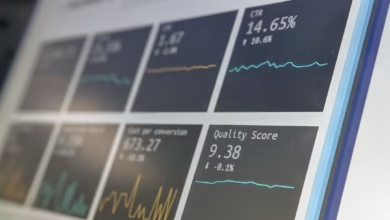Navigating the Day Trading Landscape: Essential Strategies, Tools, and Psychology for Beginners

In the fast-paced world of day trading, aspiring traders face a unique blend of opportunities and challenges. For beginners, understanding the intricacies of the market is crucial to developing effective strategies and achieving long-term success. This article serves as a comprehensive guide, outlining essential foundations for day trading and equipping newcomers with the knowledge they need to navigate this dynamic landscape.
From mastering technical analysis to predicting market movements, and employing risk management techniques to protect capital, we delve into the core components that define successful trading practices. Additionally, we explore the psychological aspects that can influence decision-making, highlighting the importance of maintaining emotional discipline in a high-stakes environment. As technology continues to reshape the trading landscape, we will also examine the rise of algorithmic trading and the role of automated systems in enhancing trading efficiency.
Finally, we’ll discuss how external factors, like news events, can impact intraday trading strategies, and recommend essential tools and platforms that can facilitate a smoother trading experience. Whether you're just starting out or looking to refine your approach, this article will provide valuable insights to help you embark on your day trading journey with confidence.
- 1. **Essential Foundations for Day Trading: Strategies and Tools for Beginners**
- 2. **Mastering Market Movements: The Role of Technical Analysis and Risk Management**
1. **Essential Foundations for Day Trading: Strategies and Tools for Beginners**
Day trading can be an exciting yet challenging endeavor, especially for beginners. Establishing a solid foundation is crucial for navigating the fast-paced world of intraday trading. Here are some essential strategies and tools that can help new traders get started.
First and foremost, understanding technical analysis is vital. This involves studying price charts and indicators to identify patterns and trends that can inform buying and selling decisions. Beginners should familiarize themselves with key indicators such as moving averages, Relative Strength Index (RSI), and Bollinger Bands, which can provide insights into market momentum and potential reversals.
Another critical aspect of day trading is developing a clear trading strategy. Beginners should consider strategies such as scalping, which involves making quick trades to capture small price movements, or momentum trading, where traders look for stocks moving significantly in one direction. It is essential to test these strategies using paper trading or simulation accounts to gain experience without risking real capital.
Risk management cannot be overstated. Establishing rules for position sizing, stop-loss orders, and profit targets is essential for protecting capital and minimizing losses. A common rule of thumb is to never risk more than 1% of your trading capital on a single trade. This disciplined approach helps traders stay in the game longer and weather inevitable losses.
In addition to strategies, the right tools are pivotal for success. A reliable trading platform with real-time data and advanced charting capabilities is essential. Popular platforms like TD Ameritrade's thinkorswim, E*TRADE, and Interactive Brokers offer features that can enhance a trader's ability to analyze the market and execute trades efficiently. Furthermore, utilizing news aggregation tools can keep traders informed about market-moving events and trends.
Lastly, maintaining a trading journal is a valuable practice. Recording trades, including the rationale behind each decision and the outcome, allows beginners to learn from their experiences, refine their strategies, and develop a more disciplined approach to trading.
By focusing on these foundational aspects—technical analysis, strategic planning, risk management, and the right tools—new traders can build a solid groundwork for their day trading journey, increasing their chances of success in the dynamic financial markets.
Day trading can be an exciting yet challenging venture for beginners. To navigate this fast-paced environment effectively, it is crucial to understand several key components.
Technical analysis plays a vital role in day trading, as it involves the evaluation of price charts and market data to identify potential trading opportunities. By analyzing patterns, trends, and indicators, traders can make informed predictions about future price movements. Familiarizing oneself with tools such as moving averages, Relative Strength Index (RSI), and candlestick patterns can significantly enhance a trader’s ability to anticipate market behavior.
Risk management is another essential aspect of day trading. Successful traders often implement techniques such as setting stop-loss orders, which automatically close a position at a predetermined loss level, thereby protecting their capital. Diversifying trades and only risking a small percentage of one's trading account on each position can also help minimize losses. Establishing a solid risk-reward ratio is crucial to ensure that potential gains outweigh potential losses.
The psychology of trading cannot be overlooked. Emotions such as fear and greed can heavily influence decision-making, leading to impulsive trades or holding onto losing positions for too long. Beginners must develop discipline and a consistent trading plan to manage their emotions effectively. This includes adhering to predetermined strategies and remaining focused on long-term goals rather than short-term fluctuations.
Algorithmic trading has transformed the trading landscape by allowing traders to utilize bots that execute trades based on pre-defined criteria. These automated systems can analyze vast amounts of market data at lightning speed, making them powerful tools for identifying trading opportunities. However, it is important for traders to understand the algorithms behind these bots and to monitor their performance regularly.
Swing trading is another strategy that can be beneficial for capturing short-term market trends. Unlike day trading, which involves making multiple trades within a single day, swing trading allows traders to hold positions for several days or weeks, capitalizing on price shifts while reducing the stress of constant monitoring.
Finally, staying informed about the impact of news and events on intraday trading is crucial. Economic reports, earnings announcements, or geopolitical events can lead to significant market volatility. Traders should develop a habit of monitoring news sources and economic calendars to anticipate potential market reactions and adjust their strategies accordingly.
Utilizing the right tools and trading platforms is essential for success in online trading. Beginner traders should look for platforms that offer user-friendly interfaces, comprehensive charting tools, and educational resources. Many platforms also provide paper trading accounts, allowing beginners to practice their strategies without risking real money.
By combining technical analysis, effective risk management, an understanding of trading psychology, algorithmic tools, swing trading strategies, awareness of news impacts, and the right platforms, beginners can build a solid foundation for their day trading journey.
2. **Mastering Market Movements: The Role of Technical Analysis and Risk Management**
Technical analysis is a crucial component of day trading, enabling traders to analyze past market data, primarily price and volume, to forecast future price movements. By utilizing various charting tools and indicators, such as moving averages, Relative Strength Index (RSI), and Bollinger Bands, traders can identify patterns and trends that may signal potential entry and exit points. This analysis allows traders to make informed decisions based on historical performance rather than relying solely on speculation or instinct.
However, while technical analysis can provide valuable insights, it is essential to pair it with effective risk management techniques. Successful traders understand that losses are an inevitable part of trading, and managing these losses is key to long-term success. Risk management strategies may include setting stop-loss orders to limit potential losses on trades, diversifying the trading portfolio to spread risk, and determining position sizes based on account equity and risk tolerance. By establishing clear risk parameters, traders can protect their capital and maintain their emotional well-being, allowing for more rational decision-making under pressure.
Combining technical analysis with robust risk management creates a balanced approach to trading, empowering beginners to navigate the complexities of the market with greater confidence. This dual strategy not only enhances the potential for profit but also minimizes the detrimental impact of emotional decision-making, leading to a more disciplined trading practice. As traders develop their skills in both areas, they will be better equipped to respond to market movements and seize opportunities as they arise.
In conclusion, venturing into day trading can be both an exciting and challenging endeavor for beginners. By understanding essential foundations such as effective strategies and the necessary tools, aspiring traders can build a solid base for their trading journey. Mastering technical analysis is crucial, as it equips traders with the skills to predict market movements and identify potential opportunities. Coupled with robust risk management techniques, traders can protect their capital and minimize losses, fostering a more sustainable trading practice.
Moreover, acknowledging the psychological aspects of trading is vital; emotions can significantly influence decision-making, making it essential for traders to cultivate discipline and emotional resilience. As the landscape of trading evolves, algorithmic trading introduces innovative methods, leveraging technology to enhance efficiency and accuracy. Additionally, staying informed about market news and events is paramount, as these factors can dramatically impact intraday trading dynamics.
Ultimately, success in day trading requires a blend of knowledge, strategic planning, and continuous learning. By embracing these principles and utilizing the right tools and platforms, beginners can navigate the complexities of the market with greater confidence, paving the way for potential success in their trading endeavors.





